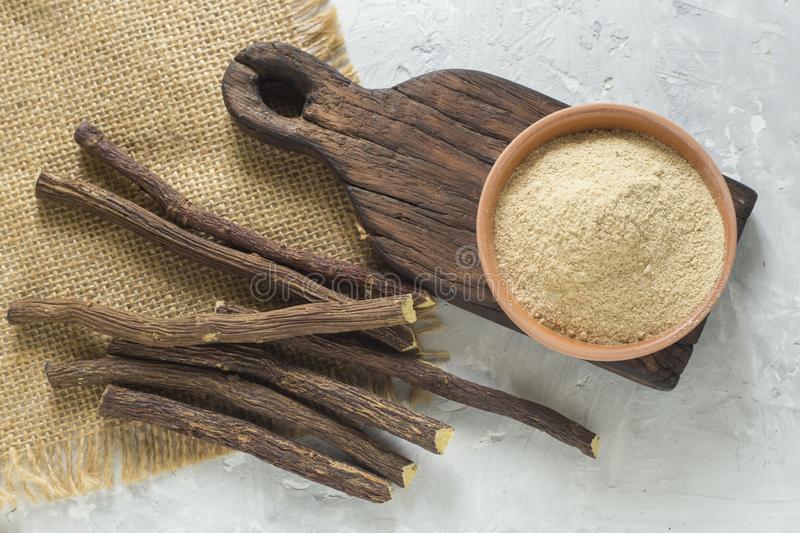Licorice is a very well known herb in traditional Chinese medicine (TCM). In China, it is called “gancao” (meaning “sweet grass”) and has been recorded in the Shennong׳s Classic of Materia Medica around 2100 BC. Licorice was supposed to have life-enhancing properties. During the following thousands of years licorice has been present in most of Chinese traditional prescriptions. It was believed to have the functions of nourishing qi, alleviating pain, tonifying spleen and stomach, eliminating phlegm, and relieving coughing.
Glycyrrhiza uralensis Fisch., Glycyrrhiza inflate Bat. and Glycyrrhiza glabra L. were prescribed as licorice in Chinese pharmacopoeia. They are widespread in Inner Mongolia, Gansu, Heilongjiang, Ningxia, Qinghai and many other provinces in China. The roots and rhizomes are the main medicinal parts of licorice. Numerous studies have revealed many pharmacological activities of licorice, such as antiviral, anti-inflammatory, antitumor, antimicrobial and many other activities. Among the pharmacological activities of licorice mentioned above, the antiviral and antimicrobial activities have been most commonly reported. Viral and other microbial infections play a critical role in many highly prevalent diseases, especially in developing countries. The development of safe and effective antiviral or antimicrobial agents is very important, and licorice deserves more attention for its outstanding activities
Licorice is one of the most widely used and extensively researched medicinal plants of the world . The word liquorice essentially derives from Old Greek glykyrrhiza, glykys means “sweet,” and rhiza is “root”. One of the main active ingredients is glycyrrhizin, which has a cortisone-like effect. Glycyrrhizin is also 50 times sweeter than sucrose. Liquorice has several names such as sweetwood, licorice, liquorice radix, reglisse (French), lakritzeholz (German), Gan Cao (Chinese), Meyan or Beyan (Turkish), Buyan (Turkmen) and Solodka (Russian).

Licorice roots have been used worldwide as a medicine and flavor in industry for over 4000 years. Medicinal uses of licorice are recorded in texts such as Assyrian Herbal (2000 BC) and Ebers Papyrus (1600 BC). Licorice is believed to have originated in Iraq. The most widely distributed species Glycyrrhiza glabra is found in Spain, Italy, Turkey, the Caucasus, Central Asia, and the western part of China whereas Glycyrrhiza uralensis is distributed form Central Asia to Mongolia and China. Various species of licorice are currently grown on commercial scale in Spain, Italy, France, Greece, India, Iran, Iraq, Turkey, Turkmenistan, Uzbekistan, Syria, Afghanistan, Azerbaijan, China, and to a limited extent in England and the United States.
Taxonomic Description
The genus Glycyrrhiza is in the family Leguminosae and about 30 species are accepted up to today including G. aspera, G. bucharica, G. echinata, G. eurycarpa, G. glabra, G. iconica, G. inflata, G. korshinskyi, G. lepidota, G. macedonica, G. pallidiflora, G. squamulosa, G. triphylla, G. uralensis, and G. yunnanensis.
Botanical Description
Licorice is a perennial herb which grows 1–2 m tall. The plant has a long cylindrical burrowing rootstock that grows to a depth for 1 m. Horizontal stolons grow outwards and typically reach 1.5–1.8 m in length, although they may grow to a length of 7 m. The bark on licorice root is dark reddish, while the inside of the roots is bright yellow. Leaves are alternate, pinnate, with 9–17 ovate, yellow-green leaflets, each 2.5–5 cm long. The spikes of pealike flowers may be white, purple, or yellow. Spikes are usually 10–15 cm long and are born from leaf axils. Seedpods are maroon, 3 cm long, oblong, pointed, and flattened. Licorice roots are harvested 3–4 years after planting
Traditional Uses
Ancient Egyptians, Greeks, and Romans recognized the benefits of licorice in treating coughs, colds, and chills. In the days of Hippocrates, licorice was prescribed for dropsy because of thirst-quenching properties of licorice drugs . The use of licorice for stomach and intestinal ulcers goes back at least to the Greek physician Dioscorides in first century AD, although modern clinical use began in about 1930. The ancient Hindus used licorice for improving sexual vigor, and Chinese for strength and endurance and they prepared it most often in tea.
In traditional medicine licorice roots have been used against treating chest and lung diseases, pneumonia, bronchitis, arthritis, bronchial asthma, kidney diseases, heart diseases, gastric ulcer, mouth ulcers, coughs, swellings, excessive salivation, fluid retention, low blood pressure, allergies, catarrhs of the upper respiratory tract, liver toxicity, hyperglycemia, Addison’s disease, pancreatic disorders, flatulence, sexual debility, skin diseases, leukorrhea, hoarseness, and certain viral infections .
Current pharmacopoeias from France, Germany, and Britain are in general agreement on the medicinal application of licorice. In Indian medicine, licorice is used for treatment of influenza, eye diseases, uterine complaints, biliousness, liver disease, and arthritis . In Chinese medicine, licorice is used to treat acne and pimples, nervous disorders such as hysteria, irritability, and epilepsy as well as reduce the toxic or drastic action of other herbs, and to harmonize herbal formulas ). In earlier studies Kong et al. showed that root extract of licorice was used to treat diarrhea in mice, whereas Hong et al. demonstrated strong diuretic activity of licorice in rats. Extract of G. glabra was used to treat emotional irritability in adults and stress . Licorice extract was also used to treat eczema ( and allergic dermatitis.
